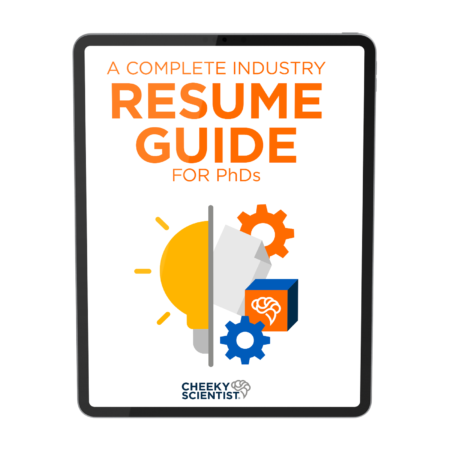Have A Ph.D.? Use These 3 Scripts To Breakthrough The Silence On LinkedIn

Robust LinkedIn network is necessary for hiring.
PhDs often think that they have plenty of time to work on the next step in their career and that they can postpone setting up a job search strategy.
Sadly, many of them wait so long that they end up in a desperate position, where they need a job yesterday.
They start fixating on things like “I gotta get hired. I gotta get somebody to help me get hired. I gotta really pitch myself. I gotta talk about all my skills, I gotta ask for help on my resume.”
So, they start bombarding people with messages that have too many words and make big asks right away. This strategy comes across as too aggressive and ends up burning bridges.
Take for example the following message that I recently received:
Hello, sir,
I am a PhD and postdoc in molecular biology, working at Harvard University Center. I have designed and synthesized molecular imaging peptide probes for labeling key lighting peptides for radio labeling, as well as unconjugated peptides, multi antigen peptides (MAPS), and peptide heterodimers bio-conjugated with proteins. I have worked with preclinical mouse models and clinical specimens.
I saw you have an open position for a senior scientist at your company, and I think I am a good fit for this role. Can you refer me for this position? Please review my resume that is attached here.
Industry employers, especially those who don’t have a PhD, have no patience for long messages with lots of technical jargon. So, the PhD gets ghosted and desperation increases, building a vicious cycle.
You might think this message is absurd. That you would never send a message like it. But you don’t know how your behaviour will change after six months of unemployment, when you start to worry about rent, healthcare, or feeding your kids.
The only way to avoid this kind of desperate message is to start reactivating your current network, expanding your network, and plan your transition now, while you still have plenty of time.
While you can take a step back and not make things about yourself. While you can focus on adding value to the other person.
Explode Your Network With A Not-About-You Mindset
At Cheeky Scientist, we talk a lot about adding value first. On focusing on your connections before asking for something from them.
Many PhDs think that they don’t have any value to add. They picture these successful industry professionals, and can’t think of something they could give that’s valuable.
But you can add value to any kind of person, you just need to see things from their point of view. Not yours.

There’s a variety of ways that you can add value: You can show appreciation as a colleague. You can complement their work or career progression. Ask for their personal opinion or advice. You can make a recommendation or an introduction.
The ideal connection request needs to be short, it needs to provide rationale, it needs to make things as easy as possible for the other person, and it needs to be targeted for each specific connection.
The number one turn off in terms of replying to someone who reaches out to you on LinkedIn is the size of the message. Industry employers will not spend time reading messages with long paragraphs. Especially if they come from someone they don’t know. So, you need to make the message as short as possible.
If your message is short, and they start reading it. They will immediately have questions that you need to answer. For example: who is this person? Why are they sending me a message?
So, provide rationale. It doesn’t have to be an impressive rationale, just something that lets them know why you are reaching out to them.
At the same time, it is your job to make things easy for them. Industry employers are busy. So, you have to show that you value their time. Don’t ask them to review your resume, or give you a referral, those are big asks. Instead, ask them to connect with you and leave everything else for future messages.
Once they reply, you can guide them to deeper levels of professional intimacy, but the first connection is what holds up most PhDs. Focus on that first.
Finally, make sure to target your connection. Different industry professionals value different things. You need to bear that in mind when sending a connection request.
3 “Golden Ticket” LinkedIn Connections You Should Reach Out To
There are three types of industry employees that you should reach out to at every company that you’re interested in. Gatekeepers, decision makers, and people working at proximal positions.
Gatekeepers are in charge of the hiring process at their company. This includes hiring managers, internal recruiters, talent acquisition specialists, and human resources (HR) employees.
Decision makers are above senior levels. In large companies, there are in middle management – executive and director positions. In middle and small companies, you can take a look at operation managers or Chief Operating Officers (COOs).
People in proximal positions are currently working in your target position, or a similar position, both vertically and laterally. This means that if you are targeting senior roles, you should connect with people in principal roles. If you are targeting positions in R&D, you should connect on LinkedIn with people in project management.
Now that you know what kind of people you should reach out to, let’s talk about the right way to reach out to each of them.
1. Proximal Positions
You should start building your network by focusing on proximal positions. Especially those who hold PhDs.
Keep in mind that these people get bonuses – $2000 on average – if they refer candidates who are hired at their companies. They have an interest in connecting with talented people, but you need to make things easy for them.
You can connect to them using the following script:
Hello [name]. I saw your post on [topic of interest] in my LinkedIn feed and I thought to reach out. Congrats on your success at [their company] in [their job title]. I’m a PhD in [relevant field] Would you be interested in connecting?
As you can see, this message is short, it provides rationale right away – you’re reaching out on LinkedIn because you are a PhD in a relevant field and saw their post, and it adds value by showing appreciation for their work and focusing on them.
These people are likely still new to industry. They haven’t received a lot of appreciation and are working hard on building their career. So, you want to focus on them as individuals and show your appreciation.
To make sure that you keep things relevant, you should zoom out when talking about your PhD. Don’t give them your academic niche. Instead, say something more general, like genetics, social sciences, or medical research.
The best way to find a relevant post is to go to their profile and look at their activity. It doesn’t matter if the post is old. What matters is that you create some rapport from the get go.

2. Decision Makers
You can take the previous networking script and tweak it to adapt it to decision makers and gatekeepers. The most important thing to keep in mind is that these people don’t care much about appreciation for themselves. So, you need to find another focus.
Decision makers put a lot of effort into positioning their company and the teams they manage. You should leverage that in your connection requests.
Here is an example script:
Hello [name]. I saw your post on [topic] related to [you company] in my LinkedIn feed and thought to reach out. Congrats on the success of your team and your company. I’m a PhD in [relevant field] and would love to be on a team like yours one day. Would you be interested in connecting?
As you can see, this message focuses on their company and their team instead of on them as individuals.
You will notice that most of their posts are about their company, so you can refer to any of them in your message.
It is also ok to mention that you would be interested in working for their team at some point. Decision makers are always looking for talent. At the same time, notice that you are not directly asking for a job, just expressing an indirect interest.
3. Gatekeepers
The final group, gatekeepers, are constantly looking for talent as part of their job. They spend up to 8 hours of their day on LinkedIn looking for suitable candidates. So, they get a lot of connection requests.
The best way to add value to this group is to save them as much time as possible by being direct in your request.
Here is the script:
Hi name. I saw your post for [open position] at [company]. And I was wondering if the position was still available? I’m a PhD in [relevant field] with experience and relevant training. Would you be interested in connecting?
As you can see this message is to the point. You are making it easily for them by mentioning the position you are interested in and the fact that you have relevant training. That is how you add value to gatekeepers.
Final Tip – Leverage Your LinkedIn InMail Messages (You Get Free Ones)
So far, we have covered the type of industry employees you should connect with and what is the best approach to reach out to each of them.
Unfortunately, even using these tried and true scripts, you will not get a connection for every request you send. Industry employees are busy and often cannot take a detailed look at all the requests they get.

On top of that, the way LinkedIn displays connection requests is weird. Requests don’t show in the inbox, but in the network tab, and they only appear as a preview, so they are easy to miss.
Your connection note will go to the inbox once the person accepts your request, but if many days have passed, it will be buried by more recent messages. Therefore, it is always a good idea to send a new message once a connection accepts your request.
But what happens if you are not even getting the new connection? Then, you need to leverage your InMail credits. LinkedIn only allows you to send direct messages to first degree connections. Otherwise, you have to send InMail messages.
Ideally, you should send a connection request and an InMail message with the same text every time, but InMail messages are limited. You get about 5 per month with a basic account and 30-40 per month with a premium account.
So, you need to be strategic about this. Save your InMail messages for people you really want to connect with and who are unlikely to catch your initial connection request.
Concluding Remarks
You should start building your LinkedIn network as soon as possible, so you can focus on doing it right, without having to deal with desperation. Start by reaching out to people in proximal positions and add value showing appreciation and focusing on them as individuals. Next, reach out to decision makers on LinkedIn by focusing on their company and showing appreciation for their team. Finally, reach out to gatekeepers by being direct and mentioning the job posting you are interested in. Don’t get discouraged if you are not getting any new connections. They are probably not seeing your requests. Leverage your InMail message to increase your chances of getting responses and show that you are a professional networker.
If you’re ready to start your transition into industry, you can apply to book a free Transition Call with our founder Isaiah Hankel, PhD or one of our Transition Specialists. Apply to book a Transition Call here.

ABOUT ISAIAH HANKEL, PHD
CEO, CHEEKY SCIENTIST & SUCCESS MENTOR TO PHDS
Dr. Isaiah Hankel is the Founder and CEO of Cheeky Scientist. His articles, podcasts and trainings are consumed annually by millions of PhDs and other professionals in hundreds of different countries. He has helped PhDs transition into top companies like Amazon, Google, Apple, Intel, Dow Chemical, BASF, Merck, Genentech, Home Depot, Nestle, Hilton, SpaceX, Tesla, Syngenta, the CDC, UN and Ford Foundation.
Dr. Hankel has published 3X bestselling books and his latest book, The Power of a PhD, debuted on the Barnes & Noble bestseller list. His methods for getting PhDs hired have been featured in the Harvard Business Review, Nature, Forbes, The Guardian, Fast Company, Entrepreneur Magazine and Success Magazine.
More Written by Isaiah Hankel, PhD































